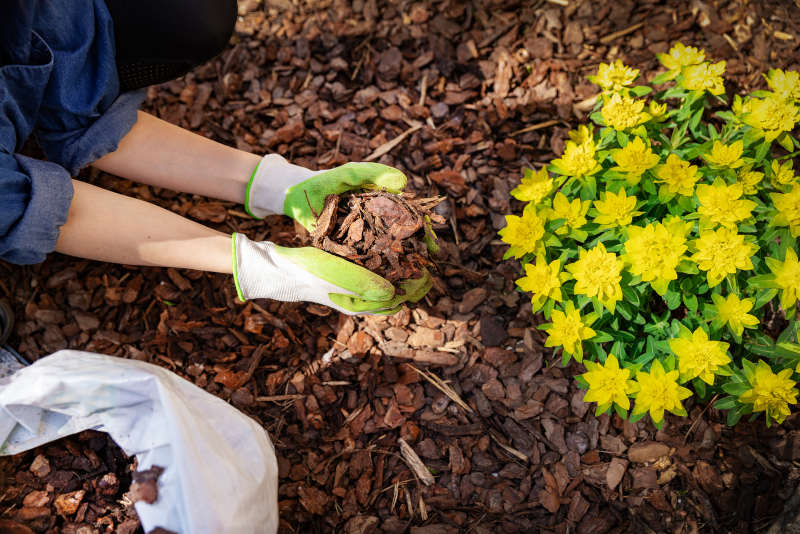Can Mulching in Spring Really Prevent Weeds All Season in Your Albuquerque Landscaping?

Landscapers get a lot of questions from gardeners and homeowners on how to best control/stop weeds from growing through the new mulch.
The following tips will help you use plant mulch successfully in your Albuquerque landscaping to control or stop weeds.
Though some perennial weeds (Canada Thistle, for example) can push their way through adequate mulch, in general where the layer is thick enough there will not be weeds growing up through the mulch.
A two- or three-inch layer of mulch is usually sufficient to keep weeds at bay without endangering the roots of your good plants. The mulch in the photo is fairly thin, if swelling it was two last years though, depleted to this extent by winter/spring, then maybe a thicker layer is in order this go-around, or a mid-year top-dressing of an inch or so would do it some good. Pine bark and cedar mulches generally bio-degrade more slowly than shredded hardwood, but the decomposition rate also depends on the microbial population in your soil as well as weathering and other environmental conditions, so it can be difficult to predict.
Post-emergent herbicides kill weeds that have sprouted and are growing; pre-emergent herbicides (one type of pre-emergent herbicide is Preen) will prevent germination and will have no effect on weeds that are already actively growing.
After applying pre-emergent herbicides, you don’t want to disturb the ground, because part of how they stop germination is by forming a chemical barrier on the surface of the soil, so digging up or hoeing weeds or raking garden mulch afterward will make an application ineffective.
So, with a normal situation where weeds are already there, they should be removed first (either hands or herbicide), then new mulch put down and then (if it is appropriate or needed to go) a pre-emergent to prevent any new growth from occurring. Most of the time, as long as you put down a new layer of mulch and not ower, as well as dropping down new pre-emergent.
Or you can use a herbicide and choose a systemic (probably an overkill for an annual weed) or a contact product, the second of which includes any organic options. Although each option may have a detrimental effect on desirable plants adjacent to them, the risk primarily comes from contact of the foliage, meaning that dormant deciduous plants such as Spirea are likely unaffected. Because contact products don’t kill roots, only above-ground growth, repeated treatments may be necessary. Contact treatment is likely all you’d require for something like chickweed — as effective as just digging it up or hoeing it out by hand — given the smaller root energy stores annuals have when compared to perennials.
Newspaper below mulch is not a great idea solution and mulch alone should be as effective, if not more. Landscape fabric (weed barrier fabric) doesn’t biodegrade and, plus, desirable plant roots may grow into the soil below and above it (as mulch breaks down into organic matter on top of the fabric, weeds can germinate in that layer, and it can even tempt roots from the desirable species to grow into that layer). There are also processes wherein landscape fabric is applied usefully, but more as a short-term method of suffocating plants that ought to be eliminated or elsewhere in other situations that are not like this one (for example wherever underneath the ground in the base of a raised vegetable bed, root-growth limitations are basic).
Follow these tips and you’ll see the positive results all season long.
